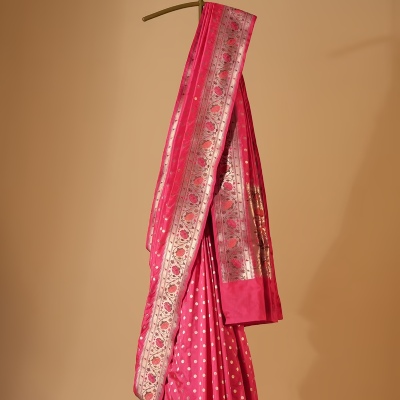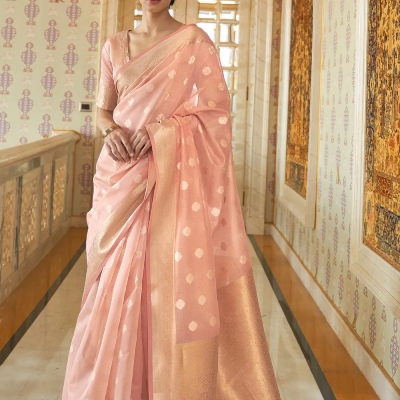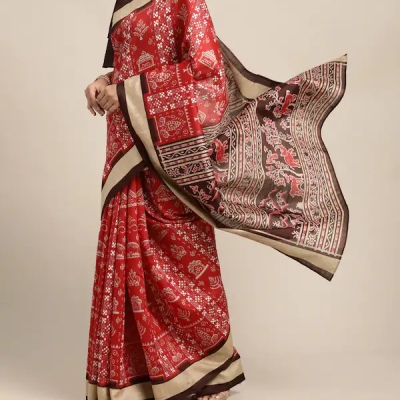In the heart of India’s rich cultural tapestry lies a treasure trove of handwoven elegance, each fold of fabric echoing centuries of heritage and artistry. Each thread is a whisper of history, each motif is a celebration of culture. These handloom sarees are not just garments; they are stories woven into threads, tales of tradition and craftsmanship passed down through generations. Let’s embark on a journey through the colourful landscapes of Indian handloom sarees, exploring their origins, histories, weaving techniques, cultural significance, and affordability.
1. Kanjeevaram Saree: Threads of Divinity
Originating from vibrant Tamil Nadu, Kanjeevaram sarees are the epitome of South Indian opulence. Their history dates back to ancient times when they adorned royal families and temple deities. The secret behind their unmatched sheen and durability lies in the use of pure mulberry silk and intricate zari work. These sarees showcase elaborate patterns inspired by temple architecture and mythology, adding a touch of divinity to the wearer’s grace. Despite their royal heritage, Kanjeevaram sarees are surprisingly affordable, making them accessible to women across the country.
You may also like: Top Brands to go for Silk Sarees
2. Banarasi Saree: The Elegance of Varanasi

Travelling north to the banks of the Ganges, we encounter the resplendent Banarasi sarees. Crafted in the city of Varanasi, these sarees bear witness to Mughal and Persian influences. The art of weaving intricate brocades with gold and silver threads was brought to India by the Mughals, and the Banarasi sarees became the canvas of this exquisite craftsmanship. Their luxurious appearance is matched by their cultural significance, often worn during weddings and auspicious occasions. Owning a Banarasi saree is like owning a piece of history and tradition.
3. Linen Saree: Breath of Freshness
From the bustling streets of urban India to the tranquil villages, linen sarees have emerged as a versatile and contemporary choice. Although not bound by centuries of tradition, these sarees exude a sense of comfort and elegance. Originating from Europe, the weaving technique made its way to India, where it has been seamlessly integrated into the Indian fashion narrative. Linen sarees, with their subtle hues and breathable fabric, are perfect for modern women who appreciate the fusion of tradition and trend.
4. Chanderi Silk Saree: Royalty in Threads

In the heartland of Madhya Pradesh lies Chanderi, a town renowned for its delicate and artistic silk sarees. These sarees blend cotton and silk, resulting in a lightweight texture perfect for Indian summers. The Chanderi weaving technique involves traditional motifs like peacocks and coins, reflecting the heritage of the region. Chanderi sarees hold cultural importance, gracing women during festive celebrations and ceremonies. Their affordability is a testament to the commitment to preserving indigenous weaving traditions.
5. Chikankari Saree: Poetry on Fabric
Embroidered with a delicate touch, Chikankari sarees hail from the city of Nawabs, Lucknow. With a history dating back to the Mughal era, these sarees are adorned with intricate hand embroidery that speaks of elegance and sophistication. Chikankari’s work typically includes delicate floral motifs, creating a timeless appeal. These sarees are not just garments; they are the embodiment of artistry and heritage, and owning one connects you to a legacy of craftsmanship.
6. Pochampalli Saree: Ikat Chronicles
Travelling to the southern state of Telangana, we encounter the mesmerizing Pochampalli sarees. Known for their bold and vibrant geometric patterns, Pochampalli sarees are woven using the ‘ikat’ technique. This involves dyeing the threads before weaving, thereby resulting in patterns that seem to dance across the fabric. Wearing a Pochampalli saree is like wearing a canvas of colours and stories, each thread narrating a tale of intricate craftsmanship and cultural significance.
7. Kantha Stitch Saree: Stitched with Love
From the charming state of West Bengal, Kantha stitch sarees emerge as a celebration of rural artistry. Kantha, which means ‘rags’ in Sanskrit, refers to the use of discarded cloth to create intricate patterns through stitching. These sarees are a labour of love, as artisans meticulously hand-stitch beautiful designs, often depicting folklore and nature. Kantha stitch sarees remind us that beauty can be found in the simplest of materials, and they hold a place of honour in Indian textile history.
8. Sambalpuri Silk Saree: Orissan Marvel

Hailing from Odisha, Sambalpuri silk sarees showcase a unique tie-and-dye technique called ‘Bandha.’ The intricate process involves tying sections of the fabric before dyeing, creating mesmerizing patterns. These sarees are a testament to the skill of artisans who transform threads into wearable art. Sambalpuri silk sarees reflect the vibrant spirit of Odisha and are often worn during festivals, adding a splash of colour to cultural celebrations.
9. Bandhani Saree: Tie-Dye Tradition
Rajasthan’s Bandhani sarees are a riot of colours, reflecting the state’s vibrant culture and traditions. Bandhani, or tie-and-dye, is a labour-intensive process where small sections of fabric are tied to create patterns before dyeing. These sarees are an embodiment of Rajasthan’s vivacious spirit and are often worn during weddings and festivals. Despite their intricate craftsmanship, Bandhani sarees are surprisingly affordable, making them accessible to women across India.
10. Patola Saree: Crafted Complexity
Venturing to the western state of Gujarat, we uncover the exquisite Patola sarees. These sarees are created using a complex double ikat technique, where both warp and weft threads are dyed before weaving. Each Patola saree is a masterpiece, taking months to create due to the intricacy of the process. Wearing a Patola saree is like draping yourself in art, and these sarees are often passed down through generations, carrying forward the legacy of Gujarati craftsmanship.
Special Mention:
Leheriya Print Saree: Waves of Color
Lastly, we explore the vibrant Leheriya print sarees from Rajasthan. This tie-and-dye technique involves creating wave-like patterns, evoking the undulating desert sands. Leheriya sarees are a burst of colours and energy, capturing the essence of Rajasthan’s vivacity. These sarees are not just a piece of fabric; they are celebrations of life and tradition, adding a touch of Rajasthani heritage to any wardrobe.
As you drape yourself in the intricate threads of these handloom sarees, you’re not just wearing a garment; you’re wearing the stories of generations past. From the intricate weaves of Kanjeevaram to the vibrant patterns of Patola, each saree encapsulates a slice of India’s diverse culture and history. Their affordability ensures that anyone can embrace the elegance and beauty of these handcrafted treasures, reminding us that the threads that bind us to our roots are, indeed, priceless. So, why just own a saree when you can own a piece of India’s soul?
We will be delighted to have your thoughts and feedback. Please write to us at [email protected]
Follow Life and Trendz on Instagram:https://www.instagram.com/lifeandtrendz/
Facebook: https://www.facebook.com/lifeandtrendz
Twitter: https://twitter.com/LifeandTrendz


Comments are closed.